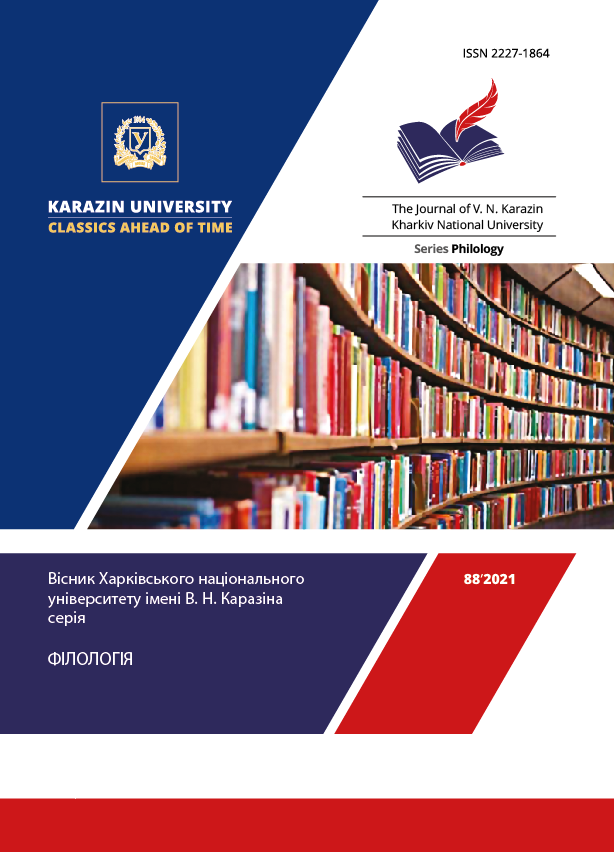Color synesthesia in modern female poetry
Abstract
A display of synesthesia in the poetic speech of contemporary artists is analyzed. The lack of special studies of synesthetic linguistic representation in modern poetry determines the relevance of the proposed investigation. In scientific interpretation, synesthesia is the interaction of words to denote emotions or other abstract or particular concepts. In linguistics, the term „synesthesia” is used to denote the mechanism of metaphorical analogy, formed on the basis of visual, taste, auditory, odorative, tactile human senses, which supply their own units to denote other conceptual areas. In modern poetry, synesthesia is productive as a mean of verbalizing subjective experiences. Furthermore, achromatic colors (white, gray, black) are actively used in poetry. Tokens to denote shades of blue (blue, cyan, blue), associated with the concept of melancholy, are also used quite often. In the analyzed poems color-sound synesthesia prevails. This fact can be explained by the physiological significance of visual and audio channels for obtaining information, as well as the genre specificity of the analyzed texts. At the syntactic level, the traditional model of a synaesthetic phrase is a combination of an adjectival colorative with a noun token to denote a concept of another conceptual sphere. The definition location in the postposition to the denoted word gives synesthetic constructions additional stylistic significance, strengthens their expressive potential. The use of complex adjectives as double epithets is a rarely used syntactic model of synesthesia. Sometimes synesthesia becomes the creative basis of the whole poetry. The analysis of synesthetic constructions makes it possible to comprehend the deep inner world of poets, features of poetic thinking, Ukrainian worldview in general.
Downloads
References
Аrutyunova, N. D. (1979). Yazykovaya metafora (Sintaksis i leksika). Lingvistika i poetika. Moskva. 164–170.
Voronin, S. V. (1982). Osnovy fonosemantiki. Leningrad: Izd-vo Leningradskogo universiteta. 244 s.
Galeev, B. M. (1999). Sinesteziya – chudo poeticheskogo myshleniya. Nauchnyj Tatarstan, 3. URL: http://synesthesia.prometheus.kai.ru/sine_r.htm (data zvernennia 12.08.2020).
Zhuravlev, A. P. (1974). Foneticheskoe znachenie. Leningrad: Izd-vo Leningradskogo universiteta. 160 s.
Zabuzhko, O. (2009). Druga sproba: Vy`brane. Kyiv: Fakt. 432 s.
Korpus ukrayins`koyi movy. URL: http://www.mova.info/corpus.aspx (data zvernennia 12.08.2020).
Levickii, V. V. (1994). Foneticheskaya motivirovannost’ slova. Voprosy yazykoznaniya, 1, S. 26–37.
Malovic’ka, L. (2009). Zvuk і kolіr: fenomen sinestezіi u tvorchomu mislennі genіya-mitcya. Aktual’nі problemi suchasnoї fіlosofіi ta nauky: tvorche, krytychne і praktychne myslennya. Zhitomir: Zhitomirs’kii derzhavnii centr naukovo-tekhnіchnoi і ekonomіchnoi іnformacіi. S. 55–58.
Minich, L. S. (2013). Synestezijni vyyavy u tvorax M. Vingranovs`kogo. Naukovi zapysky Nacional`nogo universytetu «Ostroz`ka akademiya». Seriya: Filologichna, 34. S. 157–158.
Potebnya, A. A. (1993). Mysl’ i yazyk. Kiev: Sinto. 191 s.
Sama. Antologiya suchasnoyi zhinochoyi poeziyi. (2013). Kyiv: Presa Ukrayiny. 320 s.
Ul’man, S. (1970). Semanticheskie universalii. Novoe v lingvistike, 5. S. 279–281.
Uorf, B. (1960). Otnoshenie norm povedeniya i myshleniya k yaziku. Novoe v lingvistike, 1. S. 163−164.
Shamota, A. M. (1967) Perenosne znachennya slova v movі hudozhnyoi lіteratury. Kyiv: Naukova dumka. 127 s.




